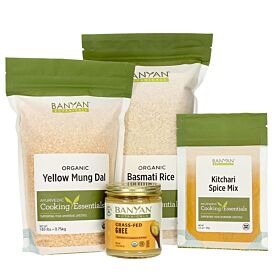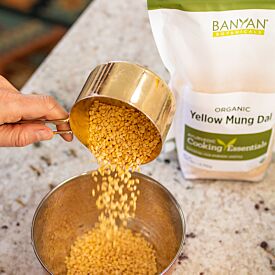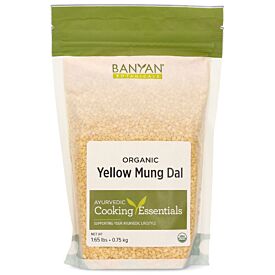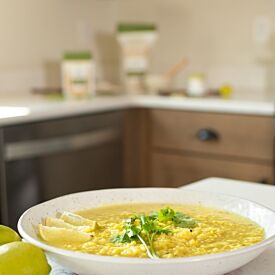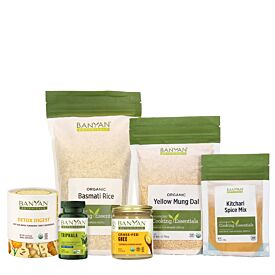How to Make Kitchari
In this article:
- Basic Kitchari Recipe
- Basic Instant Pot Recipe
- Kitchari for Vata
- Kitchari for Pitta
- Kitchari for Kapha
- Ayurveda's Staple Food
Kitchari is a delicious, thick soup that is beloved in the tradition of Ayurveda. Composed of rice, dal, spices, and other nutritious ingredients, it is extremely easy to digest, making it a staple of the Ayurvedic diet and the go-to meal for Ayurvedic cleansing. In fact, the protein content of rice and dal is an invaluable element of traditional Ayurvedic cleansing, able to sustain you throughout your cleanse without depleting you.
It is also a delicious meal in its own right, and balancing for all three doshas in Ayurveda. If you do not know your dosha or state of imbalance, we recommend taking our Ayurvedic Profile™ quiz. Once you know which dosha is most out of balance, you can choose the foods (and kitchari variations) that will balance that dosha.
In this article, we'll explore a traditional kitchari recipe, as well as some variations so you can customize your kitchari bowl for vata, pitta, or kapha. Let's dig in!
Basic Kitchari Recipe
Makes 2 servings
Tridoshic—good for all doshas
Ingredients:
- 1½ cups Rice and Dal
- 1 tablespoon Kitchari Spice Mix
- 2 tablespoons ghee
- 6 cups water
- 1–2 cups chopped vegetables (optional)
Note: the Kitchari Kit has all the basic ingredients you'll need to get started.
Optional garnishes and spice additions:
- Fresh cilantro (great for pitta—ok for vata and kapha)
- Coconut (great for pitta, good for vata, but not so good for kapha)
- Lime (ok for everybody)
- Salt to taste (optional).
Directions:
Wash Rice and Dal and soak overnight, or at least for a couple hours. This helps with the softness and digestibility of these ingredients, which in turn helps the body better assimilate the nutrients. Drain the soak water and rinse well.
In a medium saucepan warm the ghee. Add the Kitchari Spice Mix and sauté for one to two minutes. Add rice and mung dal and sauté for another couple of minutes. Then add 6 cups of water and bring to a boil.
Once the kitchari has come to a boil reduce the heat to medium-low. Cover and cook until it is tender (approx. 30–45 minutes).
If you are adding vegetables to your kitchari, add the longer cooking vegetables, such as carrots and beets, halfway through the cooking. Add the vegetables that cook faster, such as leafy greens, near the end.
Feel free to add more or less water if desired. Typically, kitchari is the consistency of a vegetable stew as opposed to a broth. A thinner consistency is preferable if your digestion is weak. You will notice that kitchari will thicken when it cools and you may need more water than you originally thought.
Notes:
- This is just one basic way of cooking kitchari. If preferred, you can also prepare the rice, dal, and vegetables separately and then mix them in a bowl after they've been cooked.
- Ayurveda recommends white rice over brown rice because it is considered easier to digest. That being said, kitchari can also be made with brown rice or other grains.
- Mung dal is recommended because of its digestibility and tridoshic quality. However, red lentils can be substituted if desired. Brown lentils are not recommended for those with vata dosha due to their drying properties.
- The following spices may be used in place of Kitchari Spice Mix:
- 1 teaspoon black mustard seeds
- 1 teaspoon cumin seed
- 1 small pinch of asafoetida (hing) powder
- 1 teaspoon turmeric powder
- 1 teaspoon coriander powder
- 4 thin slices of fresh ginger root
Basic Instant Pot Kitchari Recipe
Ingredients:
- 1 cup basmati rice, soaked overnight
- ½ cup yellow mung dal, soaked overnight
- 1 tablespoon Kitchari Spice Mix
- 2 tablespoons ghee
- 6 cups water
- 1–2 cups chopped vegetables (optional), like carrots, turnips, collard greens, kale, arugula, and chard
- Natural mineral salt
Optional garnishes and spice additions:
- Lime juice
- Chopped cilantro
Directions:
Soak mung dal and rice overnight. Drain and rinse the following day.
Place your Instant Pot on the "sauté" setting. When warm, add the ghee. After the ghee has melted, add Kitchari Spice Mix.
Once the aroma begins to lift, add the drained dal and rice and stir until well coated. Add the water.
Cook on "sauté" for about 15–20 minutes. Relieve pressure when the pressure gauge pops. Remove the lid and add your vegetables. Add salt at this stage.
Reseal the lid, moving the top to "seal." Switch to "soup/broth." Cook for 45–60 minutes. After about 30 minutes, the pressure gauge may pop. You can vent at this stage, or wait until the end to vent. The lid will remain locked until enough pressure has been relieved.
Serve with fresh cilantro and lime juice.
Notes:
To cook longer using "slow cook," use 7 cups of water, and when you add the vegetables, set it on "slow cook" instead of "soup/broth." It can cook for 4–6 hours on this setting. The longer you cook your kitchari, the more digestible it is!
To make this recipe more dosha specific, try adding 1 teaspoon fresh grated ginger for vata, 1 teaspoon fennel seed for pitta, or ½ teaspoon cayenne pepper for kapha. Add to the melted ghee when you add the Kitchari Spice Mix.
Recipe Variations for the Doshas
Although kitchari is traditionally made with basmati rice and mung dal, even these ingredients can vary. Kitchari can be nourishing or cleansing, warming or cooling, soupy or solid, all depending on the ingredients used and the method of preparation.
Generally, it is best to add ingredients that will balance your primary dosha or state of balance. Select your constitution below for more information about recommended food choices.
Vata |
Pitta |
Kapha |
Kitchari for Vata
To make kitchari more balancing for vata, increase the qualities of warmth, moisture, and stability. Kitchari already possesses these qualities when prepared the traditional way, and you can make your kitchari pot even more vata-pacifying by experimenting with the following, which can be a big support during vata season (fall and early winter) or any time you’re working to pacify vata.
Ingredients
- 1 cup white basmati rice
- ½ cup organic yellow split mung dal
- 4 cups water
- 3 tablespoons ghee
- 1 teaspoon black mustard seeds
- 1 teaspoon cumin seeds
- 1 teaspoon fresh grated ginger
- ½ teaspoon sea salt
- 2 pinches hing (asafoetida)
- ½ teaspoon turmeric
- 1 stick kombu (seaweed—you can substitute a little wakame—one “leaf” per pot of soup)
Directions:
Wash rice and mung dal and soak for three hours or overnight. Drain soak water.
In a saucepan, warm the ghee over medium heat. Add the mustard seeds, cumin seeds, and ginger, and sauté for one to two minutes. Add rice and mung beans and sauté for another couple of minutes. Then add 4 cups of water and bring to a boil.
Once the kitchari has come to a boil, add the salt, hing, turmeric, and seaweed, and reduce heat to medium-low. Cover and cook until everything is tender (approximately 30–45 minutes).
If you need to add more water to prevent scorching, please do so. The consistency should be that of a vegetable stew as opposed to a broth.
Garnish with fresh cilantro and add salt to taste. You may add a little chutney to make it even tastier.
Other Ideas:
- When your kitchari is finished, add a pinch of hingvastak powder, an Ayurvedic spice blend that strengthens vata digestion.
- Spices are great for vata. Feel free to experiment with extra spices or add salt and black pepper after cooking to strengthen agni.
- Steamed vegetables are a great vata balancing choice for side dishes, or you can have avocado with a little salt and lemon.
- For an alternative dal, you can substitute yellow mung dal for creamy urad dal. Urad dal is sweet, heavy, unctuous, and slightly heating, which is excellent for vata.
Kitchari for Pitta
When balancing pitta, focus on cooling qualities that will not overheat or aggravate this dosha, while keeping in mind the importance of enkindling the digestive fire. Try the following recipe made with cooling green mung beans and extra pitta-balancing spices for a kitchari that is particularly soothing in summer (pitta season).
If you have a predominantly pitta constitution, you may find that your strong digestive fire can cause a more voracious appetite. While kitchari is a complete protein, feel free to eat as much as needed to feel satiated. If you're cleansing, you may want to swap out your morning kitchari with oatmeal or seasoned barley on occasion if you're worried about having sufficient energy or craving additional forms of nourishment.
Ingredients:
- 1 cup basmati rice
- ½ cup whole green mung beans
- ½ of a burdock root (approx. 8 in. long), may substitute with 2 carrots
- 1½ cups of fresh green beans
- 1 small zucchini
- 2 tablespoons ghee
- ½ teaspoon fennel seeds
- 1 tablespoon Kitchari Spice Mix
- 1 teaspoon fresh grated ginger
- ½ teaspoon of mineral salt
- 1 stick of kombu seaweed
- 6 cups of water
Directions:
Wash rice and mung beans and soak for three hours or overnight. Drain soak water.
Wash and peel burdock root or carrots, and cut in your favorite way. Chop green beans and zucchini into bite size pieces—any way you like.
In a saucepan, warm the ghee over medium heat. Add the fennel seeds, Kitchari Spice Mix, and ginger, and sauté for one to two minutes. Add rice and mung beans and sauté for another couple of minutes. Then add the burdock or carrots, green beans, and zucchini, and sauté for another minute.
Add 6 cups of water and bring to a boil. Once boiling, add the salt and seaweed, and reduce heat to a medium-low simmer. Cover and cook until everything is tender (around 30–45 minutes). Add more water as needed to create the consistency of your liking.
Garnish with fresh cilantro and add salt to taste.
For extra blood and liver support, try adding bitter leafy greens like dandelion or collards.
Other Ideas:
- Try substituting basmati rice with ½ cup forbidden black rice or brown rice, like in this recipe.
- Swap out ghee for coconut oil.
- Dice up 1 large fennel bulb and a few handfuls of fresh chopped fennel fronds, then sauté them with fennel seeds and fenugreek seeds before adding rice and dal.
- For those who don't have a taste for fennel, try using bok choy, celery, celeriac, collard greens, or sweet potato in lieu of fennel bulbs. Instead of fennel seed, top with a mix of fresh cilantro and parsley.
Kitchari for Kapha
Kapha responds well to light and warming qualities, aromatic spices, and minimal use of oil. Balancing for all three doshas, this variation is especially pacifying for kapha, and especially so during late winter and spring (kapha season).
Ingredients:
- ½ cup mung dal
- ½ cup basmati rice
- 2 teaspoons ghee or coconut oil
- 1 cinnamon stick
- 2 cardamom pods
- 3 whole black peppercorns
- 2 whole cloves
- 1 tablespoon Kitchari Spice Mix
- 1 teaspoon (heaping) freshly grated ginger or ginger paste
- 1 tablespoon chopped cilantro including stems
- ⅓ cup diced carrots
- ⅓ cup peas
- ⅓ cup halved snow peas
- ½ teaspoon natural mineral salt
- 1 ¾ cup water
Directions:
Rinse rice and mung dal 2–3 times in cold water and soak for 2–3 hours or overnight.
In a 4-quart pot over medium heat, warm the ghee or coconut oil. When the oil has melted and is warm, add the whole spices: cardamom, cloves, cinnamon stick, and peppercorns. Sauté for about 30 seconds to release the aroma.
Add the Kitchari Spice Mix, and stir for about 45 seconds to 1 minute to gently activate the spices, but not burn them. Mustard seeds will begin to pop, keep a lid handy to cover if needed.
Add in the diced carrots, peas, chopped cilantro, grated ginger, and salt. Stir to meld the flavors together, about 1 minute.
Add the drained rice, mung, and water. Stir gently and bring to a boil. Then reduce the heat to low and cover. Cook for about 15 minutes, then gently stir in the snow peas and continue to simmer on low for another 7–10 minutes or until the rice and mung are cooked and the water is absorbed.
Turn off the stove and let sit covered for about 3 minutes to absorb any bits of water. Letting it sit in the steam also continues the cooking process and creates a fluffier rice without adding additional water.
Notes: Depending on the soak time, more or less water may be needed. If soaking longer, less water may be needed to prevent the rice from getting soggy.
Other Ideas:
- Top this recipe with crispy okra fries.
- Try a different recipe, substituting yellow mung dal for light, warming toor dal.
- Try using quinoa instead of rice, using the same amount that is called for in the recipe.
- Use 1 cup of spinach for steamed veggie options.
- Consider Greek yogurt as a side dish.
Ayurveda’s Staple Food
In Ayurveda, things that we ingest are divided into three categories:
- Poison
- Medicine
- Neutral
Poison is defined as anything that hinders digestion. Medicine is considered anything that we ingest that aids the digestive process. Neutral is anything we ingest that gives support and nourishment without either aiding or hindering the digestive process.
Kitchari is unique because it falls under both the neutral and medicinal categories. It not only provides nourishment for the body, but, due to its spice combination, also benefits digestion.
This makes kitchari an ideal food of choice during times of stress on the body, such as during an illness, periods of overwork, or change of seasons. It is also commonly enjoyed during and after pregnancy as part of a nourishing and rejuvenating diet.
It is also an especially good food to use while on a mono-diet as part of an internal cleansing regime. During an Ayurvedic cleanse, kitchari is recommended for all three meals, though some people like to replace kitchari with oatmeal for their first meal of the day.
In order to provide the best quality of energy to your body, kitchari should be made the day that you wish to eat it and served hot.




